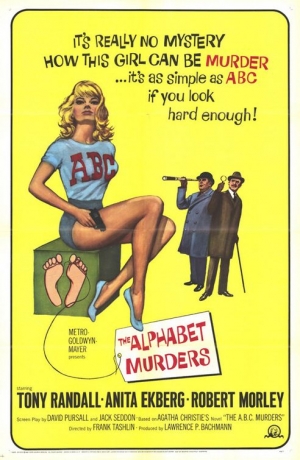
THE ALPHABET MURDERS
UK, 1965, 90 minutes, Black and white.
Tony Randall, Anita Ekberg, Robert Morley, Maurice Denham, Guy Rolf, Sheila Allen, James Villiers, Julian Glover, Clive Morton, Richard Wattis, Patrick Newell, Margaret Rutherford, Stringer Davis.
Directed by Frank Tashlin.
The Alphabet Murders is Agatha Christie light. This time Tony Randall interprets Hercule Poirot, giving him the idiosyncratic characteristics in the Agatha Christie novels. However, audiences brought up on Albert Finney, Peter Ustinov and, especially, David Suchet, might be not so amused. He is more of a caricature than a character. However, he is assisted by Robert Morley as Hastings, Morley obviously enjoying his role. The femme fatale is Anita Ekberg. There is a very strong supporting cast of British character actors. And, at one stage, as Poirot comes out of the police office, he encounters Margaret Rutherford as Miss Marple with Stringer Davis (Margaret Rutherford’s husband) as Mr Stringer.
As with all Agatha Christie murder mysteries, audience attention is directed away from the actual killer, plausible other killers are suspected and then murdered. The film has a satisfactory resolution as regards the mystery. However, along the way it is a mixture of farce, slapstick, Agatha Christie storytelling.
The film was directed by Frank Tashlin, a cartoonist who made many films for prominent comedians including Dean Martin and Jerry Lewis (Hollywood or Bust, Artists and Models) as well as six films for Jerry Lewis. He also directed comedies for Bob Hope and Doris Day.
1.Expectations of an Agatha Christie murder mystery? Of Poirot? Expectations fulfilled or not?
2.The use of the Agatha Christie novel, the outline of plot, characters, the mystery itself?
3.The black and white photography, London in the 1960s? The locations – and the street scenes, the clubs, flats? The docks? The musical score – with the jaunty touch?
4.Tony Randall’s interpretation of Poirot? His appearance, insistence on being Belgian, his vanity – and not understanding humility? His clothes, his manner, speaking and accent, misunderstood? The characteristics Agatha Christie gave him? But done more in slapstick and caricature style?
5.The encounter with Amanda, Anita Ekberg, her seeming madness, wanting Poirot to help, announcing she would commit a murder? Giving the clues? The succession of murders? The succession of initials? Her own name, Amanda Beatrice Cross? Her appearing normal at times, her eluding pursuit, the police? The relationship with Duncan Doncaster? His seeming to protect her? The confrontation on the ladder, her falling into the water? Presumed dead? Her later reappearance, the relationship with Doncaster’s half-brother? The plot, her performance, learning from the circus how to dive, the murders and the money? Outwitted by Poirot in the train?
6.Robert Morley as Hastings, the ministry, having to follow Poirot, caught out, accompanying him, being in a dither, the police, getting into trouble, assisting in the investigation?
7.The police, Inspector Japp? His being the conventional policeman?
8.The range of suspects: Duncan Doncaster, the psychiatrist, relationship with his girlfriend? Relationship with his wife? Suspicions? His half-brother and their clash? Lady Diane, her relationship with her husband, clashes, grieving at her husband’s death, the plot, her being murdered on the train? Franklin Clarke, the man about town, his spendthrift ways, under suspicion? His plot, with Lady Diane, killing her, with Amanda? Don Fortune and the other people at the club?
9.The authorities, British style? The other British characters, Wolf and his service at the clothing shop? Cracknell and his being strong on security?
10.The added touch with Miss Marple?
11.The episodic nature of the film, the variety of people killed, their initials? The investigation, Poirot under suspicion, being locked up, being bailed, his getting into trouble? Being rescued? But finally winning out in the end?